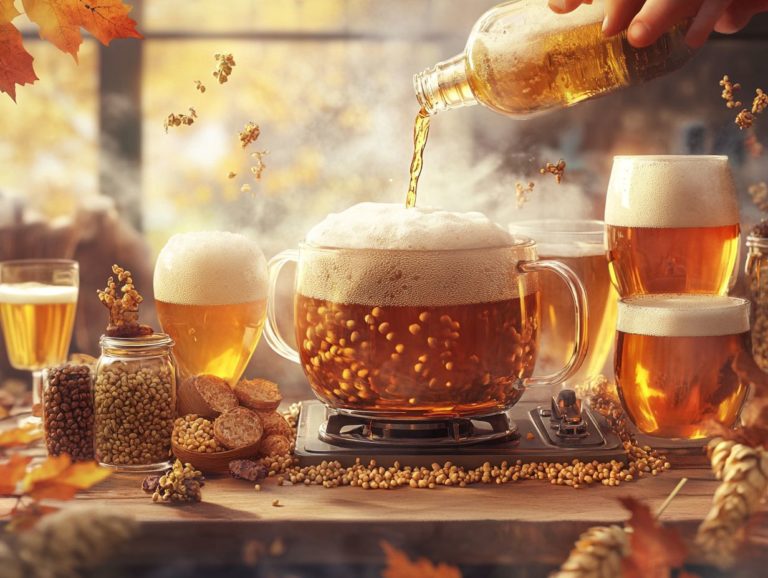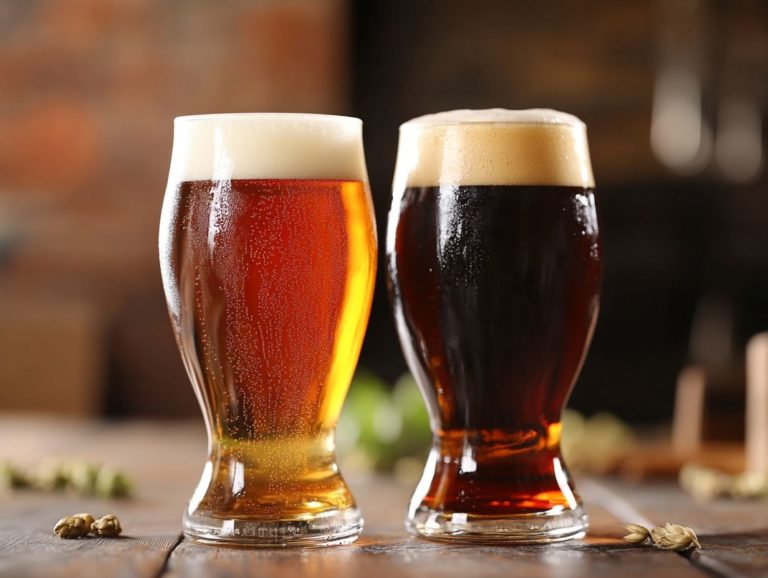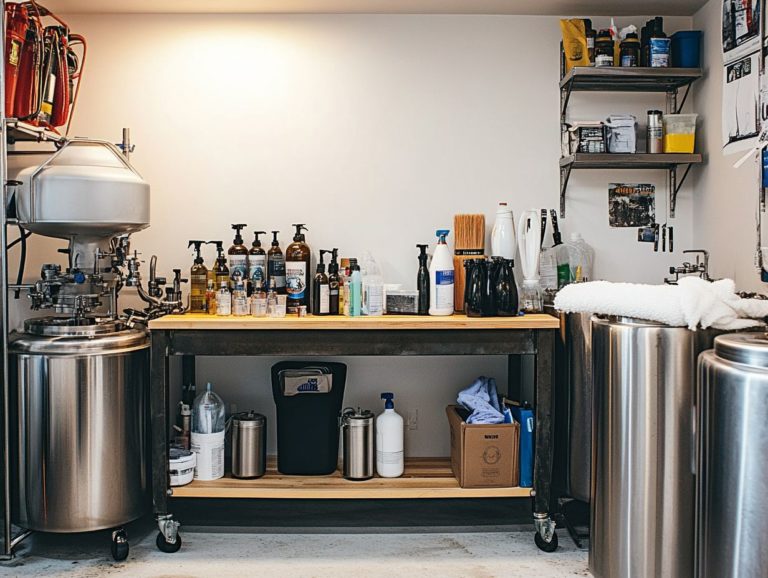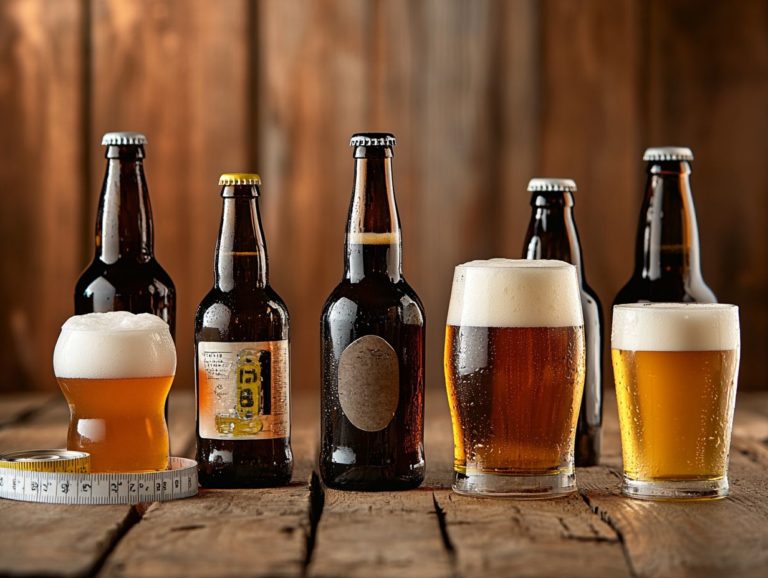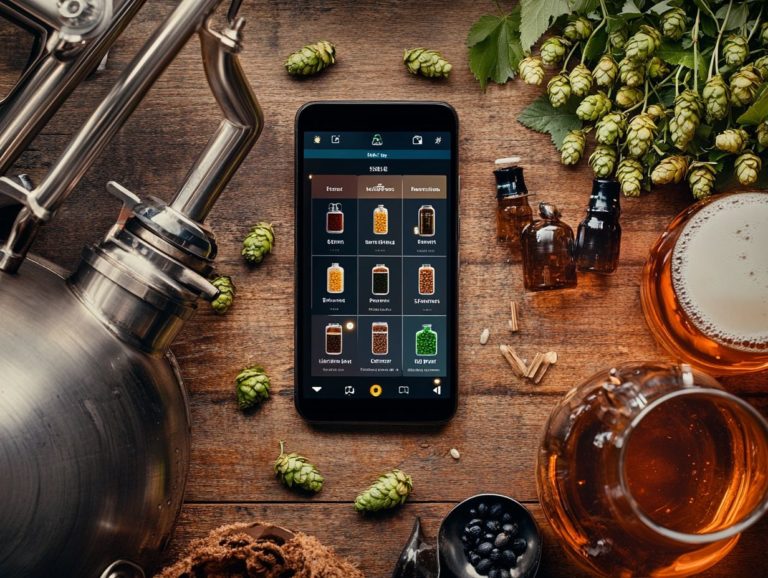What Are the Key Terms in Home Brewing?
Homebrewing has captivated enthusiasts worldwide, turning a simple passion for beer into a truly rewarding hobby. Start your brewing adventure today and taste the difference for yourself!
Whether you seek to save money, unleash your creativity, ensure quality, or connect with a vibrant community of fellow brewers, this guide delves into the intricacies of crafting your own beer or hard cider at home.
From grasping key brewing terminology and essential equipment to mastering the brewing steps, this guide provides everything you need to embark on this delightful journey. Prepare to raise a glass to your brewing adventure!
Contents
- Key Takeaways:
- What Is Homebrewing?
- Why Do People Homebrew?
- What Are the Key Terms in Home Brewing?
- Introduction to Home Brewing
- Sanitization
- Essential Equipment for Home Brewing
- Brewing Kettle: The Heart of Your Brew
- 8. Auto-Siphon
- 9. Cleaning and Sanitizing Products
- What Are the Steps for Home Brewing?
- Frequently Asked Questions in Home Brewing
Key Takeaways:
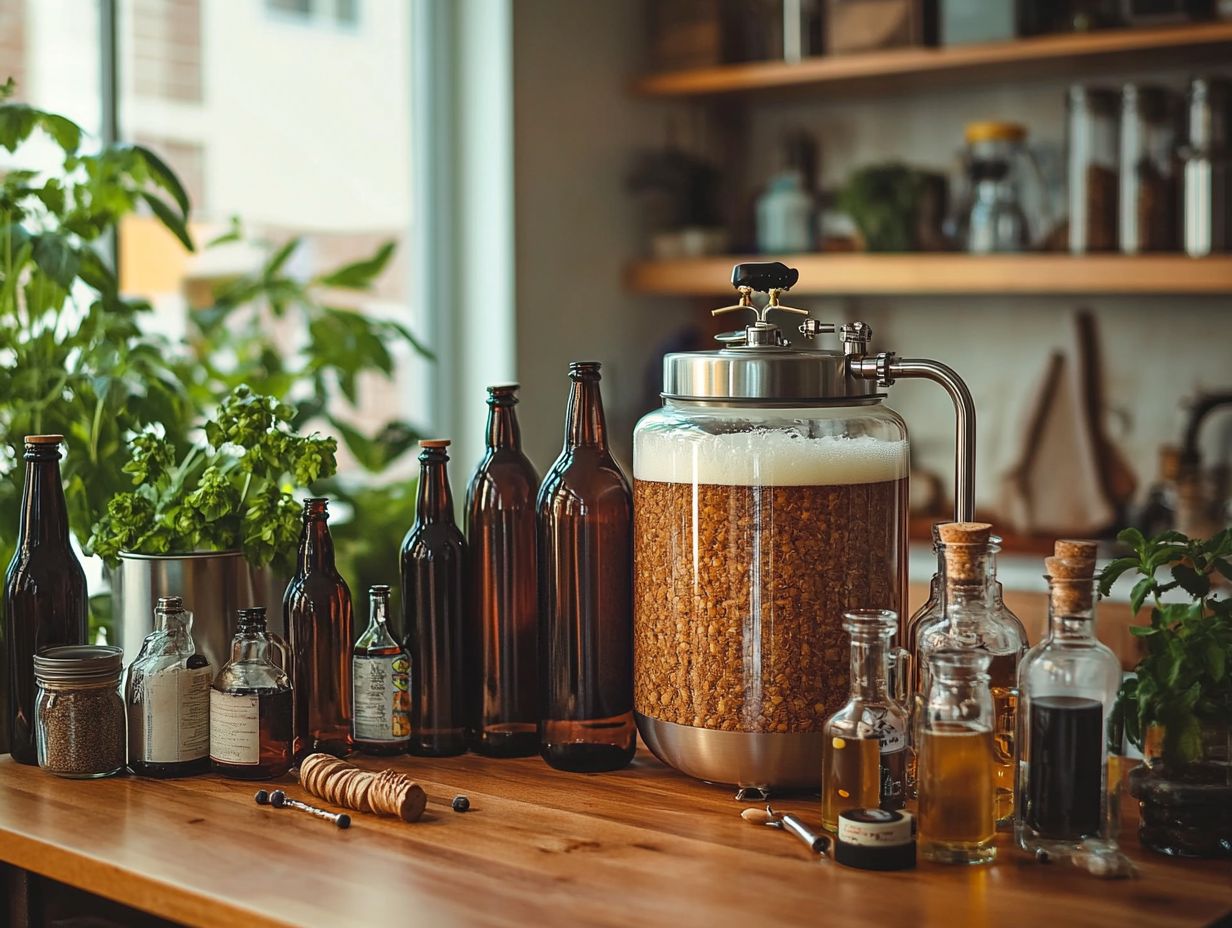
- Wort, mash, hops, fermentation, bottling, carbonation (the process that gives beer its bubbles), conditioning, gravity, ABV, IBU, SRM, yeast, Saccharomyces cerevisiae, Saccharomyces uvarum, and sanitization are key terms in homebrewing.
- Homebrewing allows for cost savings, creative control, quality assurance, and community building through organizations like the American Homebrewers Association.
- Essential equipment for homebrewing includes brewing kettle, fermentation vessel, airlock, bottles, thermometer, hydrometer, auto-siphon, and cleaning and sanitizing products. You might also consider adjuncts for additional flavors.
What Is Homebrewing?
Homebrewing is the exquisite fusion of art and science that enables you to craft beer right in the comfort of your home. This rewarding hobby grants you the freedom to experiment with a diverse array of ingredients, techniques, and styles.
As you immerse yourself in the homebrewing process, you’ll discover the joy of creating unique beverages that embody your personal tastes whether you prefer the boldness of hoppy India pale ales, the crispness of lagers, or the tanginess of wheat beer.
The journey typically encompasses essential steps, such as selecting high-quality malt, expertly managing fermentation with yeast, and carefully balancing flavors through the artful use of hops. Ensuring proper carbonation and conditioning is also crucial.
For any beer lover, homebrewing is not just a pastime; it’s an exhilarating adventure waiting to unfold.
Why Do People Homebrew?
You will be thrilled by the endless possibilities homebrewing offers. There s the sheer delight in crafting your own unique flavors and the satisfaction of taking control over the brewing process.
Homebrewing not only saves you money compared to buying commercial craft beer, but it also enables you to control the quality of your ingredients, resulting in a product that perfectly aligns with your personal taste preferences.
This creative pursuit also deepens your understanding of brewing techniques and ingredients, ultimately enhancing your overall enjoyment of beer while giving you insights into the history of brewing, such as the impact of the 18th Amendment and the 21st Amendment.
1. Cost Savings
One of the primary motivations for you to explore homebrewing is the remarkable cost savings it can offer. By brewing at home, you can create high-quality craft beer at a fraction of the price you’d pay at a microbrewery or pub.
This affordability not only makes homebrewing accessible but also invites more individuals like yourself to dive into the art of beer production, exploring diverse flavors and brewing techniques.
Consider this: when you assess the cost of ingredients like malt, hops, and yeast, you’ll find that you can produce several batches of beer for the price of a single case from the store.
While the initial investment in brewing equipment might appear daunting, you’ll quickly discover that this expense pays off as the cost of ingredients per unit diminishes with each batch you create.
By purchasing ingredients in bulk and seizing seasonal sales, you can further enhance your savings. You’ll take pleasure in crafting unique beverages tailored to your palate while knowing you’re spending less than you would on commercially available options.
This transforms each brew into not just a drink, but a gratifying experience. So, continue exploring the fascinating world of homebrewing!
2. Creative Control
Home brewing puts you in the driver s seat, giving you complete creative control over your beer recipes. You can experiment with a delightful array of ingredients and brewing techniques, tailoring your brews to match your unique taste preferences.
Whether you want to amp up the bitterness of hops, explore the rich spectrum of different malts, or add adjuncts for an extra twist, the power is entirely in your hands. By taking charge of the brewing process, you can innovate and craft beverages that truly stand out in the bustling world of commercial beers.
The possibilities for creativity in this craft are virtually limitless. You can blend traditional styles with unexpected ingredients like fruits, spices, or even chocolate, leading to thrilling new flavor profiles. Each batch you brew becomes an opportunity to refine your recipe, allowing you to tweak parameters such as fermentation temperature or yeast selection to achieve your desired results!
Plus, the community aspect of home brewing encourages the sharing of ideas and techniques, fueling even more experimentation. By documenting your processes, you not only sharpen your skills but also contribute to a vibrant culture that celebrates innovation and personal expression in the art of brewing.
3. Quality Assurance
Quality assurance is a critical component that motivates many to embrace home brewing, as it grants you complete control over the ingredients and processes that shape your final product. By choosing high-quality ingredients like malt, hops, and yeast, you can ensure your beer is free of undesirable elements like DMS or acetaldehyde, which could compromise flavor.
A solid understanding of the fermentation process enables you to produce beers with consistent taste and exceptional quality, resulting in a more enjoyable drinking experience.
Managing temperature and time during fermentation is key to maintaining quality control. You should closely monitor fermenter conditions, as even slight variations can lead to off-flavors and inconsistencies in your brews. It’s equally crucial to avoid common pitfalls, such as insufficient sanitation that invites unwanted microorganisms and over-oxidation that can dull hop character.
Adopting rigorous quality assurance practices helps you hone your brewing skills. This leads to greater satisfaction and pride in your craft. A rewarding brewing experience not only brings you joy but also impresses your friends and family, creating memorable moments that you can all share.
4. Community Building
Home brewing cultivates a vibrant community among enthusiasts, providing a supportive network where you can share experiences, tips, and resources related to craft beer production. Whether through local homebrew clubs, online forums, or events organized by the Brewers Association or CAMRA, you ll find camaraderie with like-minded individuals who share your passion for beer. This sense of community enriches your brewing experience and encourages knowledge sharing and collaboration, playing a crucial role in the growth of the craft beer movement.
Such engagement often leads to exciting collaborations on shared brewing projects. Here, you can test new recipes and experiment with diverse ingredients. Competitions further amplify this spirit, allowing you to showcase your creations and receive valuable feedback alongside well-deserved recognition.
The rise of digital platforms has made it easier for you to connect with enthusiasts from around the globe, exchanging innovative techniques or posting reviews of your latest brews. These interactions not only forge friendships but also cultivate a culture of continuous improvement and inspiration, enhancing the overall brewing community and elevating the craft beer landscape for everyone involved.
What Are the Key Terms in Home Brewing?
Grasping the essential terminology of home brewing is crucial for anyone eager to dive into this thrilling hobby, as it clarifies the intricate processes that go into beer production. Familiarizing yourself with terms like wort the liquid extracted from the mashed malt and hops, which bring that delightful bitterness and aroma, will set a solid foundation for your brewing journey.
Key concepts include fermentation, yeast, carbonation, and key measurements like Alcohol by Volume (ABV) and International Bitterness Units (IBU). A solid understanding of brewing terminology enables you to craft exceptional beers that perfectly suit your taste preferences.
Introduction to Home Brewing
1. Wort
Wort is an essential element in home brewing. It represents the liquid extracted from the mash of malted grains after they ve been steeped in hot water. This process allows the sugars from the malt to dissolve. The result is a sweet liquid that serves as the cornerstone of your beer.
After cooling the wort and adding hops, it embarks on the fermentation journey. Here, yeast works its magic, converting the sugars into alcohol and carbon dioxide, resulting in the delightful beer you savor. Be cautious of undesirable compounds like Acetaldehyde and DMS during this process.
Grasping the intricacies of wort creation is vital for any aspiring brewer. It not only initiates the fermentation process but also impacts the beer s character. The type of malt you select can give rise to a variety of beer styles, from light and crisp lagers to rich and complex stouts.
The precise balance of sugars extracted during the mashing and boiling stages will ultimately shape the body and flavor profile of your final brew. This is why understanding the terms and processes involved, such as IBU (International Bitterness Units) and EBC (European Brewery Convention) color measurements, is crucial.
Different dark malts can impart delightful chocolatey or caramel notes. Lighter malts may introduce floral or fruity hints. This showcases the pivotal role wort plays in crafting an array of diverse and flavorful beers, making it a central focus in any craft beer production.
2. Mash
Mashing is an essential step in your home brewing journey. Here, you blend crushed malted grains with hot water to activate the enzymes that convert starches into fermentable sugars. This crucial process extracts delightful flavors from the malts and produces the wort, which will later undergo fermentation.
Getting the temperature and timing just right during mashing is vital. These factors directly influence the beer’s final taste, body, and alcohol content. As a home brewer, you have the opportunity to explore a variety of grains like barley, wheat, and rye, each contributing unique flavors and characteristics to your brew.
The malting process prepares these grains, making their starches more accessible for enzyme activity. You may also experiment with adjunct grains like corn or rice to diversify the flavor profile.
During mashing, enzymes such as amylase work to break down starches into simple sugars within specific temperature ranges typically between 148 F and 158 F. Different enzyme activities peak at these temperatures, yielding varying degrees of sweetness and body in your beer.
It’s essential to consider the American Homebrewers Association guidelines for optimal results. A lower mash temperature achieves a drier finish, perfect for lighter beers. A higher temperature results in a fuller-bodied brew.
Understanding these processes enhances your flavor profiles. It also lays the groundwork for a truly enjoyable brewing experience. Don’t forget to factor in the influence of yeast strains like Saccharomyces cerevisiae for ales and Saccharomyces uvarum for lagers.
3. Hops
Hops are absolutely essential in home brewing. They not only balance the sweetness of malt with bitterness but also introduce a rich tapestry of flavors and aromas that elevate your entire beer experience. These cone-shaped flowers are packed with essential oils, offering everything from bright citrus and delicate floral notes to earthy herbal and spicy undertones.
For any home brewer aspiring to craft exceptional beer, understanding how to select, store, and incorporate hops into the brewing process is crucial. The variety of hops you choose can profoundly impact the final brew’s character.
For example, Cascade hops are renowned for their vibrant grapefruit aroma, making them a perfect fit for American pale ales. In contrast, Saaz hops are treasured for their subtle, earthy qualities, ideal for traditional Czech pilsners.
Timing is everything when it comes to adding hops. Early additions focus on bitterness, while later additions enhance flavor and aroma. By experimenting with different hop combinations, you can achieve unique profiles that showcase your creativity and personal taste.
Ultimately, mastering the art of hop usage unlocks endless possibilities for elevating the quality of your beer. This helps you craft brews comparable to those in a microbrewery or brewpub.
In conclusion, understanding the roles of wort, mash, and hops is fundamental to successful home brewing. Each element contributes significantly to the flavor, character, and quality of your beer, making them vital components of the brewing process.
4. Fermentation
Fermentation is an essential stage in your home brewing journey, where yeast eagerly consumes the sugars in the wort, yielding alcohol and carbon dioxide as byproducts. This magical transformation is what turns your sweet wort into actual beer, and the choice of yeast you make can dramatically influence the flavor profile and alcohol content of the final product.
Grasping the intricacies of the fermentation process including temperature control and timing is vital for achieving the taste and quality you aspire to in your home brewed beer. Proper fermentation techniques can also help in minimizing Acetaldehyde levels, which otherwise contribute to an off-flavor resembling green apples.
Ale yeast flourishes in warmer temperatures, leading to quicker fermentation and producing delightful fruity esters. Esters are compounds responsible for fruity flavors in beer. On the other hand, lager yeast prefers cooler conditions, resulting in a cleaner and crisper flavor.
Temperature control is paramount, as it directly impacts yeast activity and the subsequent production of esters and phenols. Phenols are compounds that can contribute spicy or smoky flavors. If fermentation runs too hot, you might end up with unwelcome off-flavors, while cooler temps could slow the process, potentially leaving you with a sweeter brew if not all the sugars are converted. This is particularly important for achieving the desired alcohol by volume (ABV) in your final product.
Monitor and adjust these conditions diligently to refine the characteristics of your final product.
5. Bottling
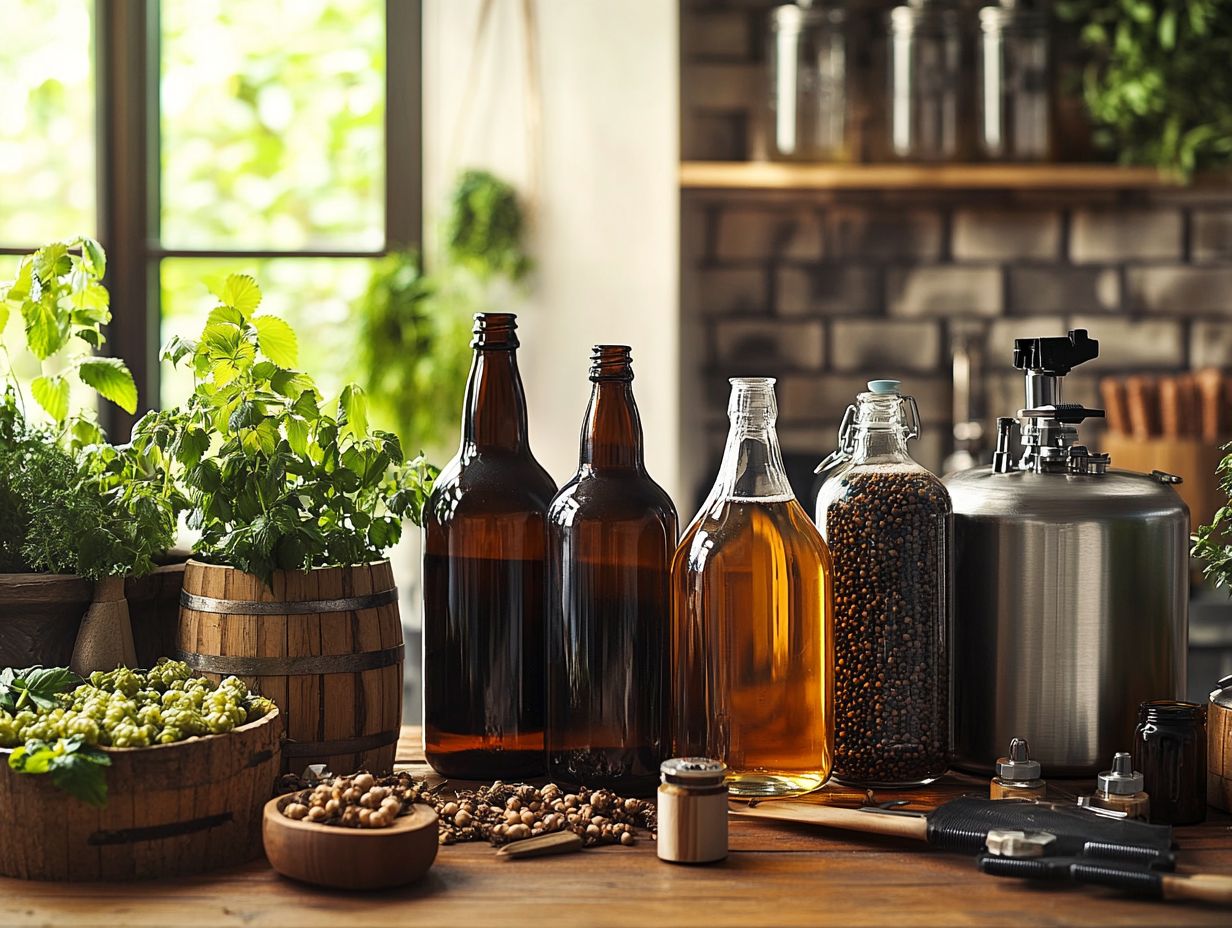
Bottling is an essential step in your home brewing journey, where your carefully fermented beer is transferred into bottles for conditioning and carbonation. This stage allows your beer to develop additional flavors and achieve that perfect level of carbonation, which is crucial for a truly satisfying drinking experience. Mastering proper bottling techniques, including meticulous sanitization and sealing, is imperative to avoid contamination and ensure your beer remains fresh and flavorful during storage. For those interested in more communal experiences, look into joining organizations like CAMRA (Campaign for Real Ale) or the Brewers Association to connect with fellow enthusiasts.
Before diving into the bottling process, take the time to thoroughly clean and sanitize each bottle. Residual bacteria can spoil your hard work, and you certainly don t want that. Consider using a no-rinse sanitizer for an efficient, hassle-free experience.
As you fill the bottles, pay close attention to carbonation levels typically achieved by adding priming sugar. This step is vital to ensure your beer is lively and effervescent, without crossing the line into overly fizzy territory.
Once you’ve sealed the bottles with caps, don’t overlook the importance of proper storage. Keeping them in a cool, dark place will help preserve their flavor and quality, allowing each brew to reach its full potential during the aging process. Your attention to these details will ultimately enhance your brewing experience and the enjoyment of your creations.
So gear up for the bottling process your beer s journey to perfection is just beginning!
6. Carbonation
Carbonation is all about that delightful presence of carbon dioxide in beer, giving you the effervescence and mouthfeel that so many beer enthusiasts cherish. As a home brewer, you have the option to achieve carbonation naturally through fermentation or artificially by adding sugar and forcing carbonation into your brew before bottling. Grasping the nuances of these carbonation methods is crucial for you, as they directly impact the quality and enjoyment of your final product.
Natural carbonation happens when yeast devours residual sugars during fermentation, producing CO2 as a lovely byproduct. This approach often leads to a creamier mouthfeel and more complex flavor profiles, with the yeast enriching your beer s overall character. On the flip side, forced carbonation involves injecting CO2 under pressure, offering you a more controlled level of fizziness and consistency across batches. Each method also influences the beer s presentation; the right amount of carbonation enhances head retention and creates visually appealing bubbles, drawing you in to savor every sip.
By cultivating a deep understanding of these carbonation techniques, you can truly elevate your craft, ensuring that every pour delights the palate, making each sip as enjoyable as those from your favorite pub.
Share your favorite carbonation technique with other home brewing enthusiasts!
7. Conditioning
Conditioning is the art of allowing beer to mature after fermentation and before it graces your glass! This is where flavors come together and refine. This aging process can occur in bottles or kegs, and the duration varies based on the beer style and the flavors you wish to achieve. Embracing proper conditioning is vital for attaining the quality and complexity that you, as a home brewer, aspire to. It permits undesirable flavors to fade away and lets your beer reach its peak taste.
During this crucial phase, a symphony of biochemical reactions unfolds, enhancing the overall profile of your creation. These reactions soften the harsher notes and craft a smoother drinking experience that is sure to delight!
Conditioning also significantly influences carbonation levels, contributing to the beer’s mouthfeel and elevating the drinker’s perception of freshness. For instance, lagers often demand a longer conditioning period to achieve that crisp, clean finish defining the style.
By understanding and valuing this essential stage in the brewing process, you can ensure that your final product not only meets expectations but exceeds them. This attention to detail can set your homebrew apart, potentially even inspiring you to explore commercial avenues like opening a brewpub or selling your beer through a microbrewery.
8. Gravity
Gravity in home brewing measures the density of your wort before and after fermentation. It directly correlates with the potential alcohol content of your final beer. Record the original gravity (OG) before fermentation begins, and then measure the final gravity (FG) once fermentation completes. This practice helps ensure that your brew nears a desired alcohol by volume (ABV).
Understanding these gravity readings is essential for you as a home brewer. They enable you to calculate the alcohol by volume (ABV) and assess how well the fermentation process is going! This metric is equally important for evaluating styles such as Wheat beer (a light and refreshing brew), Hard Cider (a fermented apple beverage), or even historical styles affected by the 18th Amendment and 21st Amendment.
By grasping these concepts, you can ensure your beer achieves the desired flavor profile and strength. A higher original gravity indicates more fermentable sugars, which can lead to a stronger beer if fermentation goes smoothly. Conversely, the final gravity reveals how much sugar lingers after fermentation, impacting your beer s sweetness and body. The balance between the two is critical in defining the taste of your brew!
This dynamic between OG and FG is crucial as it determines not only the alcohol content but also the overall characteristics of your brew. Understanding brewing terms like these helps you manage your fermentation process effectively.
9. ABV
ABV, or alcohol by volume, serves as a crucial indicator of a beer’s strength. It reflects the percentage of alcohol contained in the final product. When you venture into home brewing, accurately calculating the ABV becomes essential for grasping your beer’s potency and its impact on flavor. This measurement stems from the gravity readings you take before and after fermentation, offering invaluable insights into your beer’s characteristics!
Pay careful attention to the specific gravity measurements, as they reveal how much fermentable sugar has transformed into alcohol throughout the brewing process. The relationship between the starting and final gravity is vital. It helps you determine the ABV and predict the sweetness and body of your beer.
For example, a higher ABV often leads to a fuller-bodied beer, which can shift the balance of flavors. Some brews may taste bolder, while others feel more subdued. Understanding these nuances is key to achieving your desired flavor profile and elevating the overall drinking experience!
10. IBU
IBU, or International Bitterness Units, is your key to understanding the bitterness profile of your beer. This measurement is vital for achieving a balanced flavor by indicating how much bitterness the hops contribute to your final product. Knowing the IBU of your beer allows you to adjust your recipes, ensuring that the bitterness complements the malt sweetness.
Understanding IBU is crucial to brewing delicious beer! Different types of beer, such as IPAs and stouts, showcase varying bitterness levels. IPAs typically feature higher IBUs compared to their maltier stout counterparts. You can measure IBU using precise calculations based on the amount and timing of hop additions throughout the brewing process.
If you’re crafting a lighter lager, keeping the IBU lower might be your goal. In contrast, a bold IPA may require a significantly higher bitterness level.
Mastering IBU measurements allows you to refine your brewing skills and create beers that align perfectly with your flavor expectations. This knowledge is particularly significant when brewing popular styles like India Pale Ale (IPA) or traditional stouts. So grab your ingredients and start experimenting with your IBU levels today!
11. SRM
SRM, or Standard Reference Method, is your go-to scale for determining the color intensity of beer. This measurement helps you gauge the visual appeal of your creations. The color of beer is crucial for achieving the desired appearance across various styles, as it greatly influences how consumers perceive and enjoy your concoctions.
Familiarizing yourself with SRM allows you to select the right malts and adjuncts to hit that perfect color profile for your beers. Adjuncts refer to ingredients added to the main brewing grains, enhancing flavor and color. This is especially important for styles like porters and wheat beers, which have distinct color requirements.
To measure SRM, you ll compare the clarity and color of your beer sample to a series of standardized color standards under controlled lighting. A higher SRM value signifies a darker beer, important for styles like porters and stouts. Conversely, lighter beers, such as pilsners and pale ales, usually register lower SRM values.
The importance of SRM goes beyond aesthetics; it also influences flavor perception, as darker beers are often seen as having richer, more robust flavors.
Mastering SRM can profoundly enhance your brewing journey and improve the creation and marketing of your unique brews. This knowledge enhances your brewing experience and satisfies consumers. It s also a key aspect highlighted by brewing organizations like the American Homebrewers Association and the Brewers Association.
12. Yeast
Yeast is an essential ingredient in your home brewing journey, playing a pivotal role in the fermentation process. This process elegantly transforms sugars into alcohol and carbon dioxide. The two most common yeast strains you ll encounter are Saccharomyces cerevisiae for ales and Saccharomyces uvarum for lagers. Each strain bestows its own unique characteristics upon your final product.
Grasping the nuances of yeast, including its influence on flavor and fermentation temperature, is vital for anyone aspiring to craft exceptional beers. Beyond these primary strains, consider venturing into specialty yeasts, like Belgian or wild yeasts. These can introduce intriguing complexity to flavor profiles and aromas.
Each type of yeast contributes distinctive esters and phenols during fermentation, significantly shaping your beer’s taste and aroma. For instance, certain yeasts can amplify fruity notes in ales, while others may impart delightful spiciness or earthy undertones to your brew.
Temperature control during fermentation is another critical factor that influences yeast activity. This can modify your beer’s mouthfeel, carbonation levels, and overall balance. By experimenting with various yeast strains and fermentation conditions, you can tailor your brews to achieve the exact characteristics you desire.
Sanitization
Sanitization is a critical pillar in your home brewing journey. It ensures that every piece of equipment you use is completely free from contaminants that could spoil your beer. By adhering to proper sanitization practices, you maintain the integrity of the brewing process while significantly enhancing the overall quality of your final product.
To protect your beer from unwanted bacteria and wild yeast that can compromise both flavor and safety, it s essential to adopt effective sanitization techniques. This is crucial when working with specialty yeasts or brewing styles that demand precise conditions.
The importance of thorough hygiene cannot be overstated. Even the smallest trace of foreign organisms can lead to off-flavors, cloudiness, or worse, spoilage that renders your entire batch unpalatable. As a home brewer, you must ensure your brewing environment is as clean and controlled as possible.
This means you must sanitize all your equipment, such as fermentation containers and bottles, and ensure your workspace remains free from contaminants.
Employing techniques such as using no-rinse sanitizers and adhering to strict container handling protocols can significantly reduce the risk of issues arising from poor sanitization practices. By fostering a culture of cleanliness throughout your brewing process, you ultimately set the stage for crafting exceptional beer that meets both taste and safety standards.
Start your brewing adventure today by ensuring your equipment is spotless!
Essential Equipment for Home Brewing
When you embark on the home brewing journey, having the right equipment is absolutely essential for achieving successful and consistent results. You ll need:
- Brewing kettle for boiling the wort
- Fermentation vessel to hold the beer during fermentation
- Reliable thermometer to monitor temperatures throughout the process
- Airlock for managing carbon dioxide release during fermentation
- Bottle capper for proper sealing
Proper equipment ensures you can maintain quality regardless of whether you re brewing an IPA, a stout, or a simple pale ale.
Brewing Kettle: The Heart of Your Brew
A brewing kettle is one of the most crucial pieces of equipment in your home brewing journey. It is designed for boiling the wort to extract rich flavors and sterilize the mixture. You’ll find these kettles available in various sizes and materials, allowing you to select one that aligns perfectly with your brewing capacity and budget.
The kettle’s ability to withstand high temperatures and distribute heat evenly is essential for achieving that optimal boil, ensuring your final beer is free from any unwanted contaminants.
When choosing a brewing kettle, consider factors like material. Options may include stainless steel, aluminum, or even copper each presenting unique benefits and drawbacks. Stainless steel is popular, prized for its durability and rust resistance, while aluminum heats up quickly but may be prone to scratches. Size matters too, as kettles typically range from five to ten gallons, catering to home brewers eager to batch brew.
Features such as built-in thermometers, spigots, and matching lids can significantly enhance your brewing convenience and efficiency. Ultimately, the right brewing kettle is key to ensuring a successful brewing experience and producing quality beer in the comfort of your home.
2. Fermentation Vessel
The fermentation vessel stands as a key part in your home brewing setup, acting as the container where your wort undergoes its transformation into beer during fermentation. Typically crafted from glass or food-grade plastic, these vessels must offer an airtight seal while allowing gas to escape. Choosing the right fermentation vessel is essential for creating an optimal environment for yeast activity.
As a home brewer, you will encounter various fermentation vessel options, each has its benefits. Glass carboys, for example, are highly sought after for their transparency and ease of cleaning, permitting you to monitor the fermentation process without disturbing the environment. On the flip side, plastic buckets provide robust sturdiness and larger capacity, making them perfect for batch brewing.
Stainless steel fermenters also present an outstanding choice; they offer superior insulation and remarkable durability. When determining the best vessel for your needs, consider factors such as batch size, fermentation temperature, and the clarity of the beer you aim to achieve, ensuring you set yourself up for optimal results. Also, consider how the gravity of the wort will influence the fermentation process.
3. Airlock
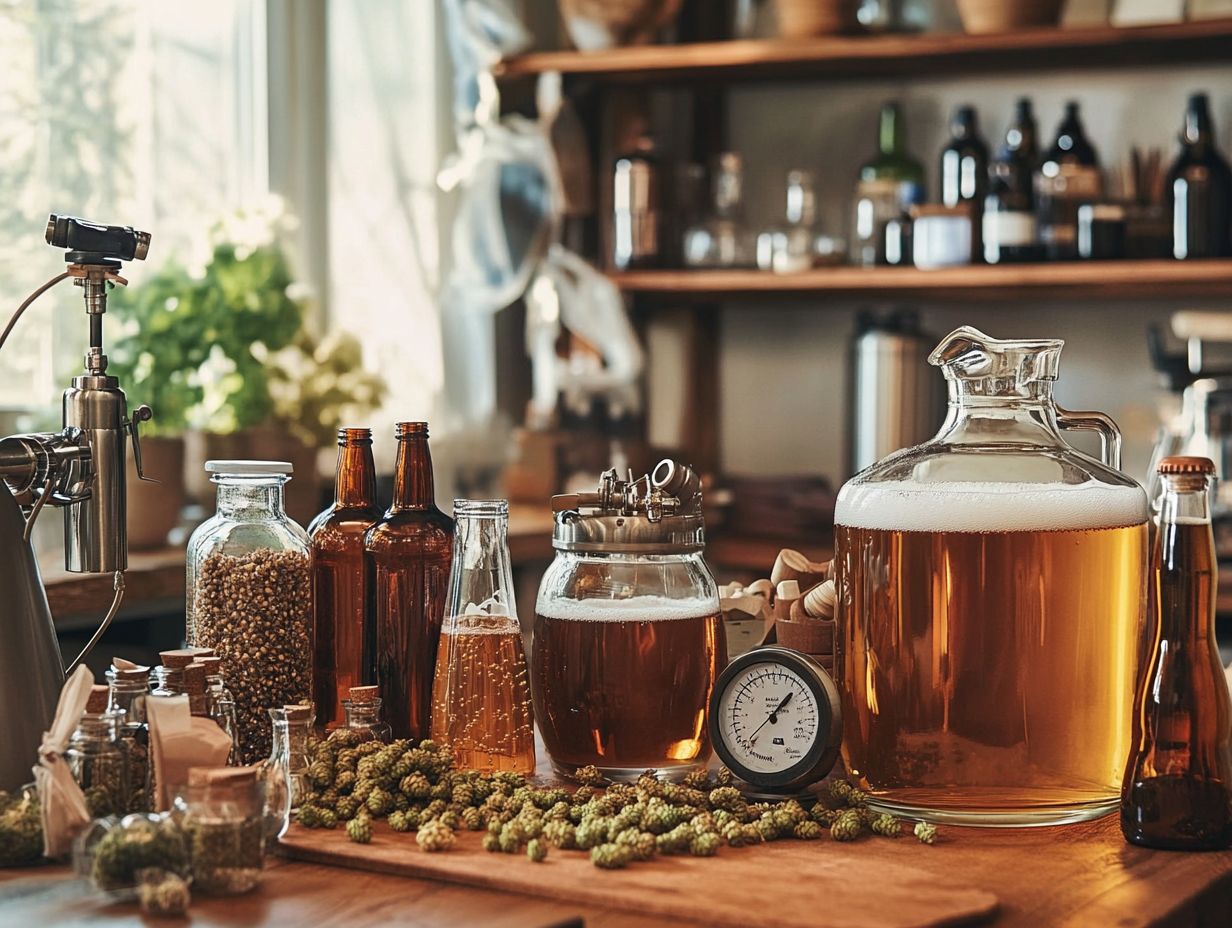
An airlock is an essential tool for your home brewing endeavors, specifically crafted to facilitate gas release during fermentation while safeguarding your brew from contaminants. This simple tool permits the carbon dioxide produced by the yeast to escape, alleviating pressure buildup and ensuring a safe fermentation process. Utilizing an airlock properly is vital for preserving the quality and integrity of the beer you craft.
You’ll discover various types of airlocks at your disposal, including the three-piece airlock, renowned for its easy-to-clean design, and the S-type airlock, which is often preferred for its dependable performance. Each type fulfills the essential role of allowing gases to escape while establishing a barrier against unwanted pathogens. Proper use of airlocks is a fundamental practice in both ale and lager brewing, ensuring each craft beer batch meets expectations.
To achieve optimal fermentation results, it s essential to regularly inspect the airlock for any blockages and to monitor the water level within it.
Using sanitized water or a suitable solution can further enhance its effectiveness in repelling contaminants, allowing you to concentrate on perfecting your brew without worry.
4. Bottles
Bottles are key to completing your brewing adventure! They play a crucial role in the home brewing journey, serving as the final resting place for your meticulously crafted beer after fermentation and carbonation. Choosing the right type of bottles whether glass or plastic is vital for ensuring proper sanitization and preventing contamination. Grasping the nuances of how to condition and store your bottles is essential for preserving the quality of your brew throughout its life.
As a home brewer, you’ll often consider the pros and cons of various bottle types. Amber glass bottles, for instance, offer excellent UV protection, keeping your beer safe from light exposure, while clear glass bottles are often chosen for their undeniable aesthetic appeal. On the other hand, plastic bottles present a lightweight and shatter-resistant alternative, making them a practical choice for many brewers. Whichever option you choose, understanding the IBU (International Bitterness Units) ratings of your beers will help in selecting the right bottle to preserve their intended bitterness.
The importance of thorough sanitization cannot be emphasized enough; any lingering bacteria or yeast can spoil your hard work, resulting in undesirable off-flavors or unexpected carbonation. Moreover, employing proper storage techniques like maintaining a consistent temperature and storing the bottles upright will significantly enhance the aging process, allowing you to enjoy a delightful, well-crafted brew for weeks or even months to come. This is especially true when dealing with complex brews like Porter or Stout, which benefit from meticulous care.
5. Bottle Capper
A bottle capper is an essential tool in the world of home brewing. It plays a crucial role in securely sealing your bottles after they’ve been filled with your carefully crafted beer. This device ensures that each bottle is airtight, preventing any potential contamination and allowing for proper carbonation that elevates your brew.
Mastering the use of a bottle capper is vital for home brewers aiming for exceptional results. You’ll find various types of bottle cappers available, including hand cappers, bench cappers, and automatic capping machines. Each type offers unique advantages suited to different brewing scales.
Hand cappers are perfect for those just starting out or for small batches. Bench cappers provide enhanced efficiency for capping larger quantities. For commercial brewers who demand speed and consistency, automatic capping machines are the ultimate choice. For members of organizations like the American Homebrewers Association, mastering these tools is part of the exciting journey toward creating exceptional home brews.
To seal your bottles effectively, ensure that the caps are clean and aligned properly with the bottle neck. A crucial best practice is to inspect each bottle for any debris before capping. Once you’ve sealed your creations, store them in a cool, dark place to help maintain the beer’s quality and flavor. Your attention to detail in these steps will make all the difference in your brewing journey.
6. Thermometer
A thermometer is an essential companion in your home brewing journey. It allows you to monitor and control the temperature with precision throughout both the brewing and fermentation processes. Accurate temperature readings are vital for triggering the desired chemical reactions during mashing and for creating optimal conditions during fermentation. This holds true whether you’re brewing an India pale ale or a Wheat beer.
Selecting a reliable thermometer is crucial for achieving consistent results and crafting high-quality beer. Temperature control is crucial; even minor fluctuations can lead to off-flavors or compromise fermentation performance.
You have a variety of thermometer types to choose from, including digital, infrared, and dial models, each offering its own set of advantages and drawbacks. For example, digital thermometers deliver quick readings, while infrared options enable non-contact measurements, particularly useful in specific scenarios. This is especially critical when dealing with sensitive yeast strains like Saccharomyces cerevisiae and Saccharomyces uvarum.
To effectively monitor temperatures, it’s wise to calibrate your thermometers periodically. Ensure they are positioned correctly during brewing and meticulously record temperature changes throughout the process. This will provide you with valuable insights for perfecting future batches.
7. Hydrometer
A hydrometer is an essential tool for home brewers. It allows you to measure the specific gravity of your wort before and after fermentation. Taking these measurements gives you exciting insights into your brew’s potential alcohol content. By taking gravity readings, you can track the fermentation process and calculate the final alcohol by volume (ABV).
Mastering the use of a hydrometer is vital for achieving the desired outcomes in your brewing endeavors. This tool is indispensable whether you’re brewing a Hard Cider or a classic ale.
This straightforward yet effective instrument consists of a sealed, weighted glass tube with a calibrated scale that floats in the liquid, enabling you to take precise readings based on how far it sinks. To obtain an accurate reading, ensure that your wort is at the correct temperature, as temperature can influence density. Then, gently lower the hydrometer into the sample.
After a brief pause, you can read the specific gravity on the scale, which is crucial for assessing fermentation progress and estimating the potential alcohol content. By consistently monitoring these readings, you can fine-tune your recipes and elevate the quality and consistency of your cherished craft beers.
8. Auto-Siphon
An auto-siphon is an invaluable tool in your home brewing arsenal. It expertly transfers liquid from one vessel to another while minimizing disturbance and contamination. This device streamlines the siphoning process and ensures that your beer is moved safely during bottling or kegging. Using an auto-siphon correctly is crucial for maintaining the quality and hygiene of your brew.
By keeping exposure to oxygen and sediment to a minimum, this tool preserves the beer’s intended flavors and safeguards its overall integrity. When using an auto-siphon, ensure that the tubing is securely connected and that the siphoning action begins gently. This prevents any vigorous splashing, which is key to avoiding the introduction of unwanted oxygen that can compromise your beer s freshness and aroma.
Using this handy device can elevate your home brewing craft, resulting in a cleaner, crisper final product that is sure to impress anyone fortunate enough to partake in your creation.
9. Cleaning and Sanitizing Products
Effective cleaning and sanitizing products are essential for you as a home brewer. They ensure that your brew remains free from contamination and meets the highest quality standards. This is crucial for preventing issues like DMS and Acetaldehyde from affecting your beer.
To achieve this, familiarize yourself with a range of products tailored to various cleaning needs, including alkaline cleaners, acid cleaners, and non-chlorine sanitizers. Each type has its own specific function. For example, alkaline cleaners excel at removing stubborn residues, while acid cleaners efficiently tackle mineral buildup. Understanding the recommended contact times and dilution ratios for these products can significantly boost their effectiveness.
Incorporating routine best practices like cleaning your equipment right after use and not overlooking those hard-to-reach areas they’re crucial for achieving exceptional brews. Proper sanitation not only preserves the flavor but also elevates your overall brewing experience.
What Are the Steps for Home Brewing?
The home brewing process is an art that unfolds through a series of specific steps, each essential for crafting delicious and satisfying beers. It all starts with the critical task of sanitizing your equipment to prevent any unwelcome contamination. Understanding the history of brewing is important, as it provides valuable context to modern practices.
Next, you prepare the wort (the liquid extracted from the malted grains), a fundamental component that sets the stage for flavor. Once the wort is boiled and hops are added, cool the mixture before introducing the yeast. This step is crucial as it influences the overall taste and aroma of your ale or lager, two popular styles in brewing.
As fermentation takes place, carefully monitor the process, leading up to the bottling and conditioning stages. Throughout, pay attention to gravity readings to gauge progress. Finally, savor the fruits of your labor and enjoy the rich rewards of your brewing journey. This end result could be a robust porter, a creamy stout, or even a refreshing wheat beer.
1. Sanitizing Equipment
Proper sanitization lays the groundwork for excellent brewing. Sanitizing your equipment is a crucial first step in the home brewing process, as it guarantees that all your tools and vessels are free from any contaminants that could spoil your beer.
To achieve effective sanitization, you should utilize appropriate cleaning solutions and ensure that every surface is meticulously cleaned before you dive into the brewing process. This step is vital for maintaining hygiene and ensuring the quality of your final product, whether you’re brewing at home or in a microbrewery.
Proper practices may include soaking your items in a sanitizer solution, such as iodine or a type of sanitizer commonly used in brewing, followed by a thorough rinse with hot water to eliminate any residues. It s also wise to adopt a no-touch method when handling sanitized equipment using clean cloths or gloves is highly recommended to avoid introducing unwanted bacteria or wild yeast.
Using commercially available beer-specific sanitizers can instill confidence in your process. Don t forget to sanitize not just your brewing vessels but also essential items like airlocks, spoons, and fermentation buckets.
This creates a contamination-free brewing environment whether you’re using adjuncts or sticking to traditional ingredients. Your attention to detail is paramount for a successful brew, ensuring the flavor and integrity of each batch.
2. Preparing the Wort
Preparing the wort is a crucial step in your home brewing journey. Here, you extract the rich flavors and sugars from malted grains through the artful process of mashing and boiling.
This mixture forms the very foundation of your beer, whether it’s an IPA or a stout, and the quality of the wort you create will directly influence the final product. Getting the temperature just right and timing the boiling process accurately is essential for maximizing flavor extraction and achieving proper sterilization.
Choosing the right types of grains is vital. Each grain imparts its own unique character to your brew.
Once you ve milled the grains, the mashing process kicks off, typically occurring between 148 F and 158 F. This is where enzymes spring into action, converting starches into fermentable sugars.
After that, you ll boil the wort for anywhere from 60 to 90 minutes. This step not only sterilizes your mixture but also introduces hops, which add both bitterness and delightful aroma.
By paying meticulous attention to each of these steps, you can elevate the complexity and richness of your beer. This ensures a final product that truly reflects your unique brewing style and expertise, whether you’re aiming for a high IBU (International Bitterness Units) beer or something with more subtle flavors.
3. Adding Hops
Adding hops is a pivotal moment in your homebrewing journey. This step directly affects both the bitterness and flavor profile of your final beer.
The timing of your hop additions during the boiling process can dramatically transform the taste. Early additions will pack a bitter punch, while late additions will elevate the aroma, infusing your brew with delightful fragrances.
As a homebrewer, you ll typically categorize hop additions into three primary types: bittering hops, flavor hops, and aroma hops. Bittering hops are your go-to for the beginning of the boil, around the 60-minute mark, where they extract maximum bitterness from the alpha acids.
Flavor hops can be introduced with 15 to 30 minutes left in the boil, allowing the more delicate flavor compounds to remain intact. And don t forget about aroma hops; add these in the final moments or at flame-out to capture those fleeting aromatic oils.
This strategic timing not only shapes the bitterness but also contributes to the intricate layers of flavor that define your beer. From floral and fruity notes to earthy and spicy undertones, the right hop additions will elevate your brew to a whole new level, making it a true craft beer.
4. Cooling the Wort
Cooling the wort is a crucial step in your home brewing journey. This process prepares the mixture for fermentation by lowering the temperature to the ideal level for pitching yeast.
Rapid cooling is vital, as it helps prevent the growth of unwanted bacteria and creates a thriving environment for the yeast. Many home brewers use immersion chillers or plate chillers to quickly reach the desired temperature. This ensures that the Saccharomyces cerevisiae or Saccharomyces uvarum yeast is in optimal condition.
You can also use cold water baths or counterflow chillers to speed up the cooling process. The speed at which you cool the wort is essential; a gradual drop in temperature can lead to undesirable off-flavors and a potential wild yeast invasion.
When you chill the wort properly, it gets the yeast excited and ready to produce your delicious brew! This quick start to fermentation influences the quality and flavor profile of your finished beer, whether it s an ale, lager, or even hard cider.
Don t wait too long to pitch the yeast into the cooled wort; the sooner you do, the quicker fermentation can begin, which is vital for crafting clean and consistent brews.
5. Pitching the Yeast
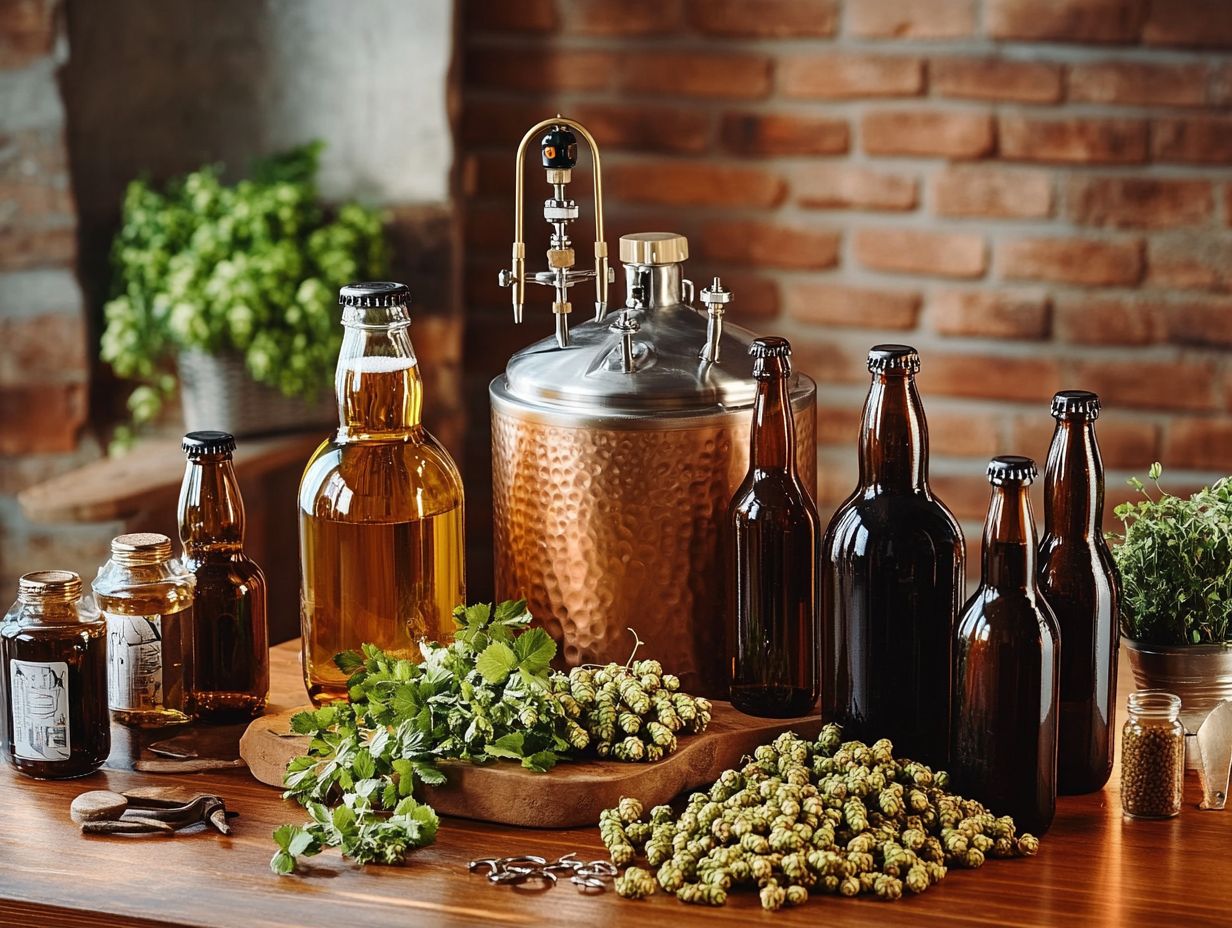
Pitching the yeast is a key step in your home brewing journey, marking the transition from wort to beer as fermentation kicks off. This step involves adding yeast to the cooled wort. It s essential to ensure that the wort is at the ideal temperature and has been properly oxygenated to give the yeast a healthy start.
Many home brewers create a yeast starter, which is a small batch of yeast and wort that helps to establish a strong fermentation. This maximizes flavor development and influences the final alcohol content and taste of your beer.
The temperature at which you pitch the yeast is crucial for achieving optimal fermentation results. Generally, you should cool the wort to around 65-75 F, which is the perfect range for the specific yeast strain you re using.
Methods of oxygenation like vigorous stirring or using an aeration stone are vital for promoting yeast health and activity. By effectively incorporating oxygen, you help the yeast thrive, leading to a faster and more vigorous fermentation. This ultimately affects the Alcohol by Volume (ABV) and overall quality of your brew.
Using a yeast starter not only enhances yeast viability but also minimizes lag time. This allows for a cleaner fermentation profile, elevating the overall quality of your beer.
6. Fermentation
Fermentation serves as the essence of home brewing, where yeast works its magic, converting the sugars in your wort into alcohol and carbon dioxide, ultimately crafting the beer you savor. During this critical phase, it s essential for you to monitor the fermentation vessel closely, keeping an eye on temperature and gravity readings to ensure that yeast is thriving and that the fermentation process flows seamlessly. Understanding the role of Saccharomyces cerevisiae and Saccharomyces uvarum types of yeast used in brewing can be beneficial.
Monitoring Fermentation Conditions
To start, maintaining an optimal temperature is of utmost importance. Different yeast strains come with their own specific temperature ranges, which can dramatically influence the flavor and aroma profiles of your final product. Regularly checking gravity readings with a hydrometer or refractometer allows you to track the specific gravity over time, offering valuable insights into the fermentation progress and helping you estimate the Alcohol by Volume (ABV).
Understanding Yeast Activity
When you notice bubbles in the airlock, it s a promising sign of active fermentation, but keep an eye out for signs of yeast settling as well this will provide further confirmation of your yeast’s activity. Equipping your brewing space with a thermometer and possibly a temperature control system can dramatically enhance your fermentation journey, setting you up for success in every brew you create.
7. Bottling and Carbonation
Bottling and carbonation are the pivotal final steps in your home brewing journey, where you transfer the fermented beer into bottles and allow it to carbonate, whether naturally or artificially. To kickstart this carbonation process, you ll want to add a precise amount of sugar right before bottling, which helps the yeast continue producing that delightful carbon dioxide. Mastering proper bottling techniques and conditioning is essential for achieving the perfect level of fizziness and ensuring the quality of your final product, whether you’re crafting a traditional ale or experimenting with flavors like hard cider.
During this stage, your attention to sanitation is paramount. A meticulous approach can prevent contamination, which could otherwise compromise the flavors and stability of your beer. Once you ve successfully transferred your brew into bottles, the significance of conditioning becomes evident; this is the period when your beer matures and its flavors evolve beautifully over time. Proper conditioning reduces off-flavors like acetaldehyde. This leads to a smoother, refined beer.
To optimize this process, store your bottles upright in a cool, dark space. This encourages the absorption of carbon dioxide and helps you achieve that gratifying effervescent quality. After a couple of weeks of anticipation, get ready to savor the delicious results of your hard work: a well-balanced brew perfect for savoring or sharing with friends at your next gathering.
8. Conditioning and Aging
Conditioning and aging are the final steps in refining your beer. These stages allow the flavors to meld and mature, enhancing the overall profile of your brew. Whether conditioning in a bottle or a keg, maintaining the right conditions is essential for a successful outcome. This is where the art of brewing truly shines, elevating your beer to craft beer status, appreciated by aficionados and casual drinkers alike.
These essential steps allow your brewed beer to mature and develop its full spectrum of flavors before you take that first sip. Whether in bottles or kegs, the duration of this process varies depending on the beer style. By giving your beer the time it needs to condition, you can refine its taste, minimize any unwanted flavors, and elevate the overall drinking experience.
The maturation phase is crucial for unlocking your beer’s potential. During conditioning, the yeast continues to metabolize residual sugars, contributing to a smoother mouthfeel and more intricate flavors. As your beer ages, oxidation a chemical reaction that can change the flavor over time introduces complex notes that may not be apparent right after brewing. This gradual transformation often results in a richer, fuller-bodied beer, turning your final product into an evolving experience rather than just a drink. The flavors during this phase can include hints of Acetaldehyde, which can give beer a green apple flavor, and other compounds.
For many brewers, grasping the nuances of this process is vital for crafting high-quality beer that not only impresses the palate but also showcases their artistry and brewing skills.
9. Enjoying Your Home Brew and Craft Beer
Enjoying your home brew is the rewarding culmination of your brewing journey. It allows you to appreciate the fruits of your labor and share them with friends and family. Tasting your homemade beer is an exciting chance to discover the unique flavors and aromas that reflect your personal choices and creativity. This experience enhances your appreciation for craft beer and connects you to the vibrant community of home brewers and beer enthusiasts.
As you pour your creation into a glass, take a moment to admire its color and clarity, which hint at the style and ingredients you ve used. Gently swirl the liquid to release the aromas, inhaling deeply to pick up on the hints of malt, hops, or any other additions you ve infused. When it s time to taste, let the beer coat your palate, tuning into the array of flavor notes, from bitter to sweet and everything in between.
Engaging with your brew in this way elevates the experience, allowing you to savor each sip while sharing the story of its creation or the inspiration behind its unique blend. You might even enjoy discovering the different beer styles, from India pale ale (IPA) to Wheat beer, Porter, and Stout.
Frequently Asked Questions in Home Brewing
What are the key terms in home brewing?
The key terms in home brewing include ingredients, equipment, brewing process, fermentation, and bottling.
What are the main ingredients used in home brewing?
The main ingredients used in home brewing are water, malted barley, hops, and yeast. Other ingredients such as grains, sugars, and spices can also be used for flavor and variety. Some brewers experiment with adjuncts to add unique characteristics to their beer.
What equipment is essential for home brewing?
The essential equipment for home brewing includes a brewing kettle, fermenter, thermometer, hydrometer, airlock, and bottles. Optional equipment can include a mash tun, wort chiller, and bottling bucket. Investing in quality equipment can significantly affect the brewing process and final product.
What is the brewing process in home brewing?
The brewing process in home brewing typically involves steeping grains, boiling the wort with hops, cooling the wort, adding yeast, and fermenting the mixture. The process can take 4-6 hours depending on the recipe and equipment used. The brewing process is an art that allows for creativity and precision, which is why many brewers take pride in each batch they produce.
What is fermentation and conditioning in home brewing?
Fermentation is the process of converting sugars in the wort into alcohol and carbon dioxide by adding yeast. This occurs in a fermenter over a period of 1-2 weeks. Conditioning is the period after fermentation when the beer matures, developing its full flavor profile and carbonation through natural processes.
What is bottling and carbonation in home brewing?
Bottling is the final step in the home brewing process. The fermented beer is transferred into bottles for carbonation and conditioning.
This usually takes 1-2 weeks before the beer is ready to be enjoyed. Proper bottling is crucial for achieving good carbonation, which is the process of adding carbon dioxide to the beer, creating bubbles, and preserving flavor.
Get ready to savor your homemade brew! Proper bottling not only enhances flavor but also makes your beer refreshing and enjoyable.

